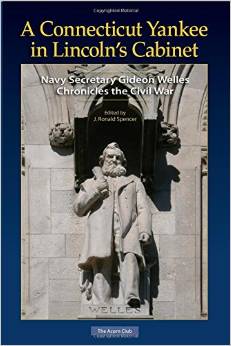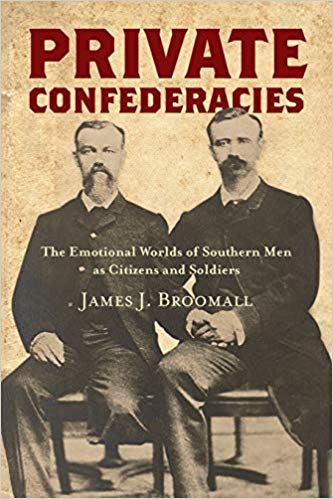A Connecticut Yankee in Lincoln’s Cabinet: Navy Secretary Gideon Welles Chronicles the Civil War edited by J. Ronald Spencer. The Acorn Club, 2014. Paper, ISBN: 978-0615961033. $24.95.
 Few primary source accounts of the Civil War era are better known or more widely used than the diary of Gideon Welles, the Secretary of the Navy under Abraham Lincoln and Andrew Johnson. There are two complete editions of the diary, one edited and published by Welles’s son Edgar in 1911, and the other by historian Howard K. Beale in 1960. In A Connecticut Yankee in Lincoln’s Cabinet: Navy Secretary Gideon Welles Chronicles the Civil War, editor J. Ronald Spencer provides today’s readers with 250 of the most important and incisive excerpts from the diary, arranging them topically. The size – three volumes – of both the Edgar Wells and the Beale editions precludes most readers from using Welles’s diary for anything other than research. The result of Spencer’s editing is a manageable and readable edition of Welles’s diary that will allow for a better understanding of one of only two men to hold their cabinet position throughout the entire Lincoln administration.
Few primary source accounts of the Civil War era are better known or more widely used than the diary of Gideon Welles, the Secretary of the Navy under Abraham Lincoln and Andrew Johnson. There are two complete editions of the diary, one edited and published by Welles’s son Edgar in 1911, and the other by historian Howard K. Beale in 1960. In A Connecticut Yankee in Lincoln’s Cabinet: Navy Secretary Gideon Welles Chronicles the Civil War, editor J. Ronald Spencer provides today’s readers with 250 of the most important and incisive excerpts from the diary, arranging them topically. The size – three volumes – of both the Edgar Wells and the Beale editions precludes most readers from using Welles’s diary for anything other than research. The result of Spencer’s editing is a manageable and readable edition of Welles’s diary that will allow for a better understanding of one of only two men to hold their cabinet position throughout the entire Lincoln administration.
Spencer opens the book with a biographical overview of Welles, before moving to an interesting discussion of the differences between the 1911 and 1960 editions of the diary. After leaving the Navy Department in 1869, Gideon Welles revised portions of the diary—even adding new material. His son, in preparing the diary for publication, deleted passages, apparently because he thought they might offend the still living whom Welles had criticized. In preparing the 1960 edition, Howard K. Beale compared the earlier publication with the original at the Library of Congress, in the process restoring Welles’ original diary. Spencer revisited the work of Edgar Welles and determined that most of the revisions he made were done simply to bring greater clarity to the diary, and did not alter the tone or opinions Gideon Welles expressed. Therefore, Spencer uses Edgar Welles’s edition as the basis for his book, but reverts to the Beale edition for those instances when the original meaning of passages is needed.
In October 1863, Welles recorded that his work on the diary “usually consumes a late evening hour, after company has gone and other labors of the day are laid aside” (3). Even after days at the Navy Department filled with the minute details of naval procurement, Welles still found the time and mental acuity to make some of the most perceptive comments on the major players of the Union war effort. This is the great strength of Spencer’s book; Welles holds nothing back, and this edition of the diary captures him at his best. Thus we get Welles’s take on Union General-In-Chief Henry W. Halleck (“a pretty good critic of other men’s deeds and acts, but as incapable of originality or directing military operations” [49]), Major General George G. Meade (“he is considered rather a ‘smooth bore’ than a rifle” [87]), and especially New Hampshire Senator John P. Hale (“Oh, John P. Hale, how transparent is thy virtue! Long speeches, loud professions, Scriptural quotations, funny anecdotes, vehement denunciations avail not to cover thy nakedness, which is very bald” [67]). Welles’s opinions, however, do not always match those of modern historians; for example, in August 1864, he wrote that he had “an awakening apprehension that [Ulysses S.] Grant is not equal to the position assigned him” (92) and even two days before Lee’s surrender at Appomattox, Welles wrote that while Grant was a “man of undoubted military talent and genius” he was “however, too regardless of life” (93).
Spencer’s topical arrangement is most effective in providing the reader with a glimpse of the inner workings of the Lincoln cabinet. These are some of the most famous passages of Welles’s diary, including the speculation that Secretary of State William Seward was attempting to make himself the administration’s “premier,” Welles’s recounting of how Lincoln announced his intention to issue the Emancipation Proclamation, and Welles’s vital role in quelling a near revolt of the cabinet over Lincoln’s reinstatement of George B. McClellan to command before Antietam. There is, perhaps, no better example of Lincoln’s maturation as the administration’s chief executive than Welles’s depiction of the cabinet crisis of December 1862 that led to the resignations (refused by Lincoln) of Seward and Secretary of the Treasury Salmon P. Chase. Welles summarized Lincoln’s view of the episode in characteristically succinct language: “The President feels that he is under obligations to each, and that both are serviceable. He is friendly to both. He is fond of Seward. He respects Chase. Seward comforts him; Chase he deems a necessity” (47).
An additional benefit of Spencer’s arrangement of material is that it provides a glimpse into the inner workings of the Navy Department, the intersection between naval administration and political patronage, and the pressures Welles faced in transitioning from a political figure of statewide importance in Connecticut to one of national consequence. Welles, for example, once awarded a navy yard to Philadelphia rather than New London. In response to the criticism and controversy the decision engendered in his home state, he wrote, “I am acting for the country, not for any section and though I have a partiality for my State, and for New London, the shopping port of my father in former years, yet I should be unworthy of my place were I to permit local or selfish interests of any kind to control me against what is really best for the country” (133).
J. Ronald Spencer provides a manageable way to glean the best from Gideon Welles’s famous diary, and allows for a better understanding of how Lincoln and his administration dealt with the vital issues of the period. If the condensed way in which the material is presented potentially leaves the reader with the impression that events came in more rapid succession than they actually did, this is a small price to pay for the accessibility and outstanding selection of excerpts that this book provides.
Peter C. Vermilyea teaches in the Department of History at Western Connecticut State University.



